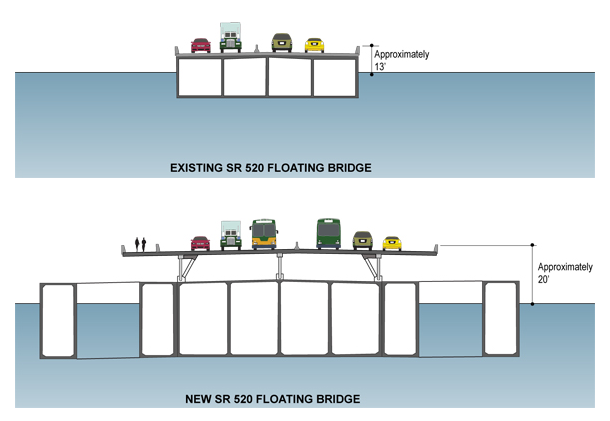U.S. District Court Judge Ricardo Martinez, who, before vilification begins, it must be noted kept the Sonics lease-breaking argument out of arbitration, dismissed yesterday a lawsuit brought against Washington State’s construction of a new SR 520 bridge. The lawsuit claimed that Washington’s Department of Transportation hadn’t conducted adequate review of alternatives before settling on a 6-lane expansion of the floating part of the bridge (growing to 12 lanes, counting on- and off-ramps, at Montlake).
“Our analysis was thorough and exhaustive, and we hope that the ruling by Judge Martinez puts an end to the debate about mobility improvements to this vital corridor,” said state Transportation Secretary Paula Hammond. With the court’s decision, WSDOT can continue with construction of SR 520 improvements as planned and funded.
Small caveat: all the SR 520 improvements aren’t funded. The state is still searching for more than $2 billion of the $4.65-billion project, so that the floating bridge portion can connect to Montlake. So, financially at least, a huge caveat.
The verdict was not particularly surprising: WSDOT has been aggressive with its timeline for the bridge construction, which has the effect of creating a sunk investment if the project is delayed or halted. Opponents of the bridge’s expansion have had difficulty bending any “ears of power.” In this economic climate, few are interested in taking the political hit sinking the mega-bridge would require. Besides, beyond the hundreds of millions of dollars already spent, many voters still believe extra lanes necessarily equal improvements in traffic flow.
Still, this is a sobering finding for anyone who thinks that an environmental impact review would lead to outcomes that impact the environment less. The Coalition for a Sustainable 520 had plenty of arguments to make on that score (the Montlaker blog summarizes a few of them for you), not least the much-remarked-upon improvement in traffic flow that has come from tolling the existing 4-lane bridge, and the mostly-ignored requirement to define how an expansion would fit with state’s goals to reduce greenhouse gases.
In Judge Martinez’s view, the option of a tolled, 4-lane, “transit-optimized” bridge deserved consideration didn’t come into the question of “improving the mobility of people and goods across Lake Washington in the SR 520 corridor.” (Here is where Sightline’s now-29-part series on the decade-long plateau (and actual decline) in traffic volumes around the state makes good reading.) Thus, the final environmental impact statement could compare WSDOT’s 6-lane preferred alternative to doing nothing at all–and nothing else–and still present the “reasonable alternatives.”
The conclusion, that there are no reasonable alternatives to the preferred alternative, has a strikingly Politburo-esque tone. As does the rationale used to eliminate the tolled 4-lane option: The toll cost would impact the poor, and divert traffic to I-90. (WSDOT argues that it is fine to do both of these things if you are funding a megaproject.) Sound reasonable?

